Randall Tesserae: Inspiring Battersea

Award-winning ceramic artist and architect Maria Gasparian shares an insight into her creative process as well as a fragment of Wandsworth’s rich cultural heritage, one which has inspired her new public artwork for Battersea.
In 2023 I was commissioned by Wandsworth Council to create public artwork for the new housing development at the Surrey Lane Estate. Colourful ceramic interventions will be permanently integrated into the paving and street furniture in the new public realm.
The artwork is inspired by the legacy of Jesse and Henry Rust Victorian mosaic manufacturers, who produced colourful vitreous mosaics in Battersea and lived on Randall Street, which was located on what is now the Surrey Lane Estate.
Using research into local heritage and through engagement with members of the local community, the artwork will bring forth a creative history of Battersea and contribute to the sense of place at Randall Close.
Colourful Tesserae
At the end of the 19th century, prolific mosaic manufacturers Jesse Rust and his son Henry Jesse lived and worked in Battersea. The company produced brightly coloured vitreous mosaics (tesserae). First located in Lambeth, the company moved to Battersea, changing its name several times from ‘Jesse Rust of Lambeth Glass Works’ to ‘Jesse Rust Vitreous Mosaic Co’ and finally to ‘Rust & Son’, when Jesse’s son Henry Jesse joined the firm in 1890.
Jesse was an innovator and patented his new production method of fusing recycled glass, sand and pigments, which produced richly coloured mosaics. ‘Any colour and shape can be made in a fused state’ he wrote. While molten, the mass was either pressed into moulds to create geometric designs or into squares to be broken up for mosaics pieces. By the end of the 19th century the firm manufactured colourful vitreous material and employed women and girls to produce mosaics. Artists’ sketches were used to create mosaic compositions, which were attached to paper backing and transported to be installed in buildings around the country.
Rust’s mosaics were commissioned by prominent Victorian architects and designers, including Henry Cole, Alfred Waterhouse and Charles Voysey, in public buildings in London and across the UK. These enriched the interiors and created special features within the walls, ceilings and floors. Extremely durable, mosaics created carpet-like decorative surfaces featuring pictorial and geometric motifs that told stories and created unique spaces.
Battersea Arts Centre features well preserved floors with flying bees and, floral and geometrical borders made with Rust’s tesserae. Other examples in London include the former Hotel Russell (1898) at Russell Square and the London, Edinburgh & Glasgow Insurance Co on Euston Road (1906-07), which currently houses the Royal College of General Practitioners. Here the subject matter draws on ancient mythology with signs of the Zodiac executed in brightly coloured mosaics in the Hotel Russell and greenish-black and white mosaics in the Euston Road building. In the Victoria and Albert Museum Rust’s black and white mosaics created a ‘fitted carpet’ with stylised floral motifs, geometrical boarders and intricate ornamental medallions.
Important archaeological discoveries of the 19thcentury and the Great Exhibition of 1851 fuelled the imagination of Victorian architects and designers. European tours, Ancient Greek, Roman, Egyptian, Islamic and Oriental motifs provided inspiration for ornamentation and colour in architecture and everyday objects at the time. Arts and Crafts, the major aesthetic and social movement of the late 19thand early 20thcenturies in England, stressed the importance of decorative arts, craft materials and techniques in architecture. These influences can be seen throughout the rich heritage left by Jesse and Henry Rust.
Rust’s mosaics offers a fascinating perspective of how craft, patterns and colour could enrich surfaces and create unique public buildings and spaces.

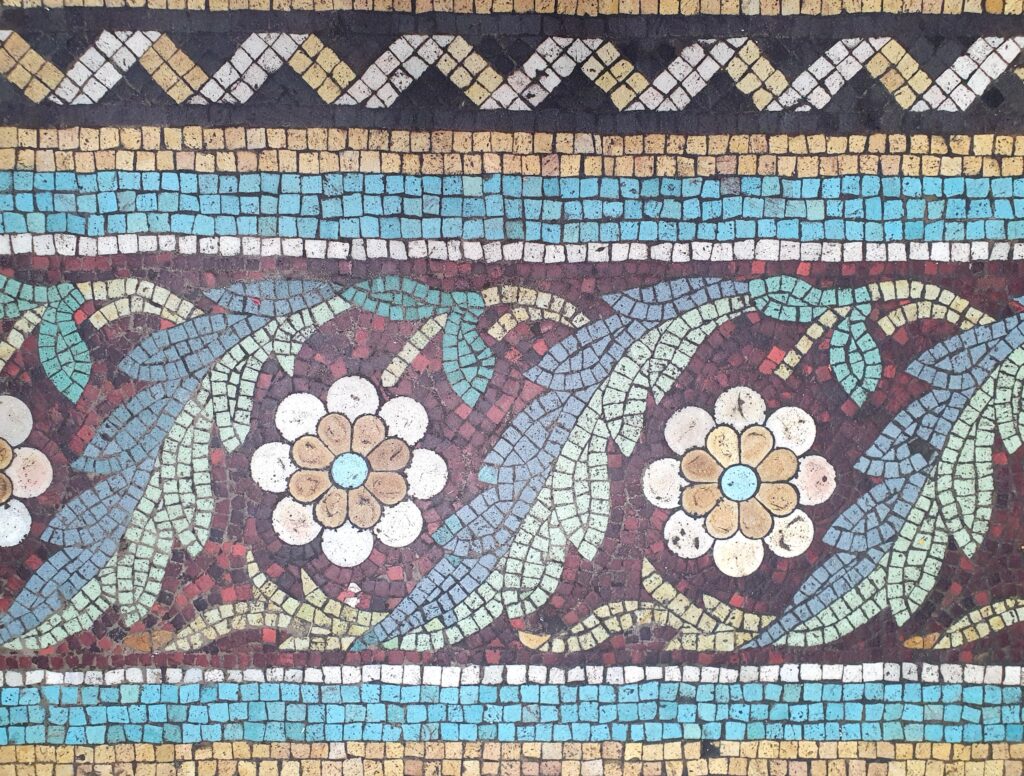

Battersea Art Centre entrance mosaic floor



Hotel Russell entrance mosaics


London, Edinburgh & Glasgow Insurance Co entrance mosaics
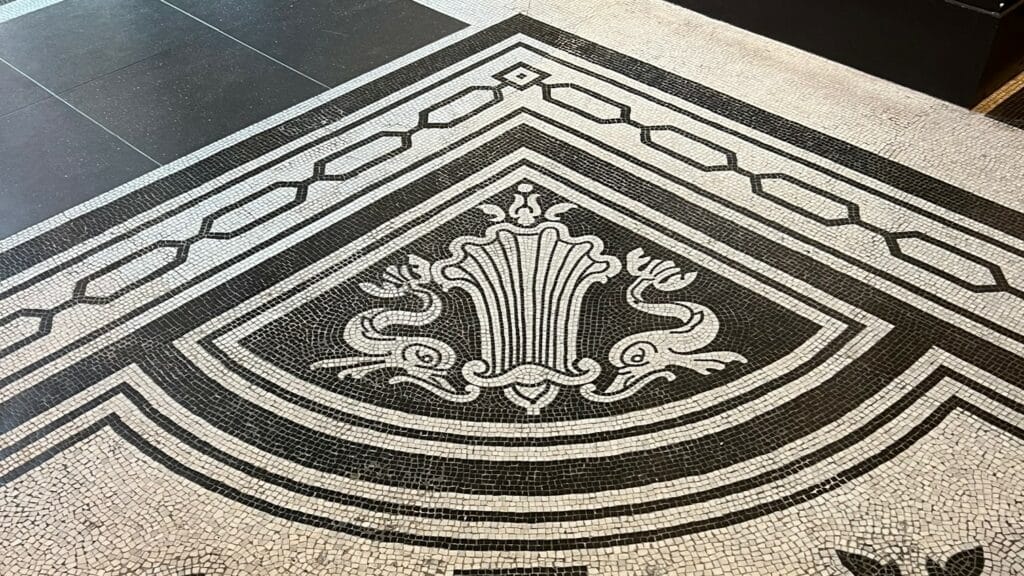
Victoria and Albert Museum mosaics at the ground floor
Local collaboration
Year 10 GCSE Art students from St John Bosco College were involved in the exploration of the local heritage and have contributed to the development of temporary public artworks at Randall Close.
Artist and illustrator Augusta Akerman and I led creative workshops with the students combining discussions about local history and architectural heritage with hands-on making sessions. We explored the colours, patterns and motifs of the Rust Mosaic Company. The students were introduced to a new print-making technique. Using individual foam stamps, a range of motifs and patterns were printed on paper using colours from Rust’s mosaic chromatic scale.
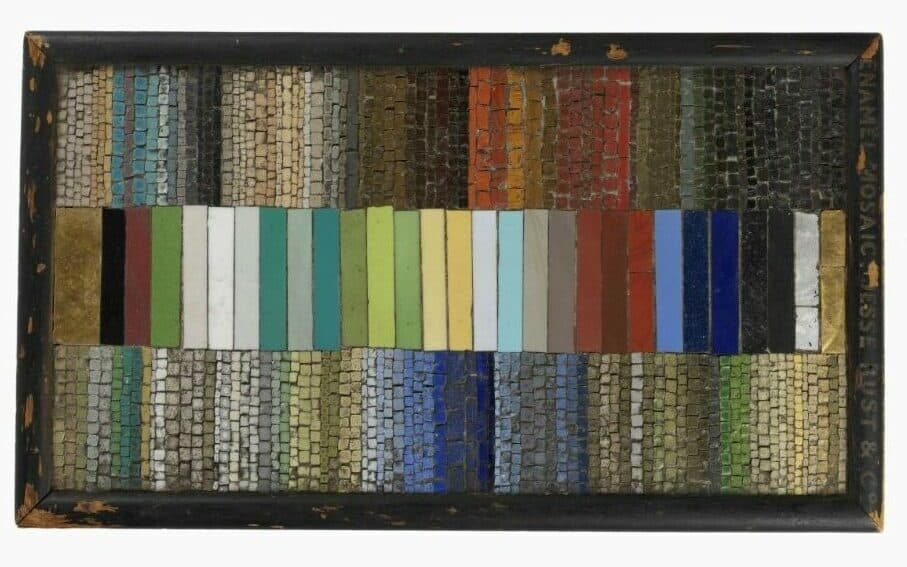

Jesse Rust Vitreous Mosaic Co trade sample boards: chromatic scale and pattern samples. Photographs © Victoria and Albert Museum
We discussed the meaning and use of ornamentation in different cultures and how repeat patterns can be made and used in architecture. The students explored the local area and conducted a photographic survey of ornamental detailing in Victorian buildings.

Examples of stamps and patterns

Decorative detailing in local historic buildings






Drawing, making, stamping: St John Bosco students creating prints inspired by Rust & Son Mosaics
The prints produced by the students during the sessions were used to create ‘Randall Tesserae’, two large-scale collaborative artworks that have been printed and installed on hoarding sections surrounding the construction site of the new development. The artworks can be seen on Battersea Bridge Road and within the Surrey Lane Estate throughout 2023 and into 2024, while construction is taking place.



‘Randall Tesserae’, 2023, Collaborative hoarding artwork, Battersea Bridge Road

‘Randall Tesserae’, 2023, Collaborative hoarding artwork, Surrey Lane Estate
As part of the development of permanent public artworks a ‘Meet the artist’ session took place, where we talked to some of the local residents and discussed the past and present of the area and what people value and enjoy in outdoor public spaces.
Creative interventions
Integration of art in architecture and urban spaces has millennia long tradition. Leading aesthetic and social movements at the beginning of the 20th century believed that public art improved people’s quality of life.
During my recent PhD research and Winston Churchill Travelling Fellowship I undertook extensive studies into historical and contemporary examples of tactile and colourful ceramic art interventions in the public realm. Some of these examples are shown below and continue to provide inspiration and influence my work.
Similar to the Arts & Crafts movement in England, the Amsterdam School (1910-1930) in the Netherlands promoted the integration of decorative art into architecture. The architects of the movement believed that ‘beauty should not be restricted to the elites of the society, but instead should be used to improve all of society’. In Het Schip social housing complex (1910) in Amsterdam expressive brick detailing and sculptural elements by municipal sculptor Hildo Crop were placed on the corners of buildings, within the towers and at the entrances to the flats.

Sculpted corner details of Het Schip apartment blocks, 1919, Amsterdam
“Housing is not enough” was the slogan for the 1920-30s Somers Town social housing development in Camden, pronounced by Friar Basil Jellicoe, the founder of the St Pancras House Improvement Society. Here Gilbert Bayes, a renowned British sculptor was commissioned to create colourful ceramic roundels and sculptural finials to uplift the outdoor spaces of the new social housing.

Gilbert Bayes, 1920-1930, Somers Town, Camden. Ceramic detailing in the window arches,
featuring Hans Christian Andersen’s The Wild Swans fairy tale
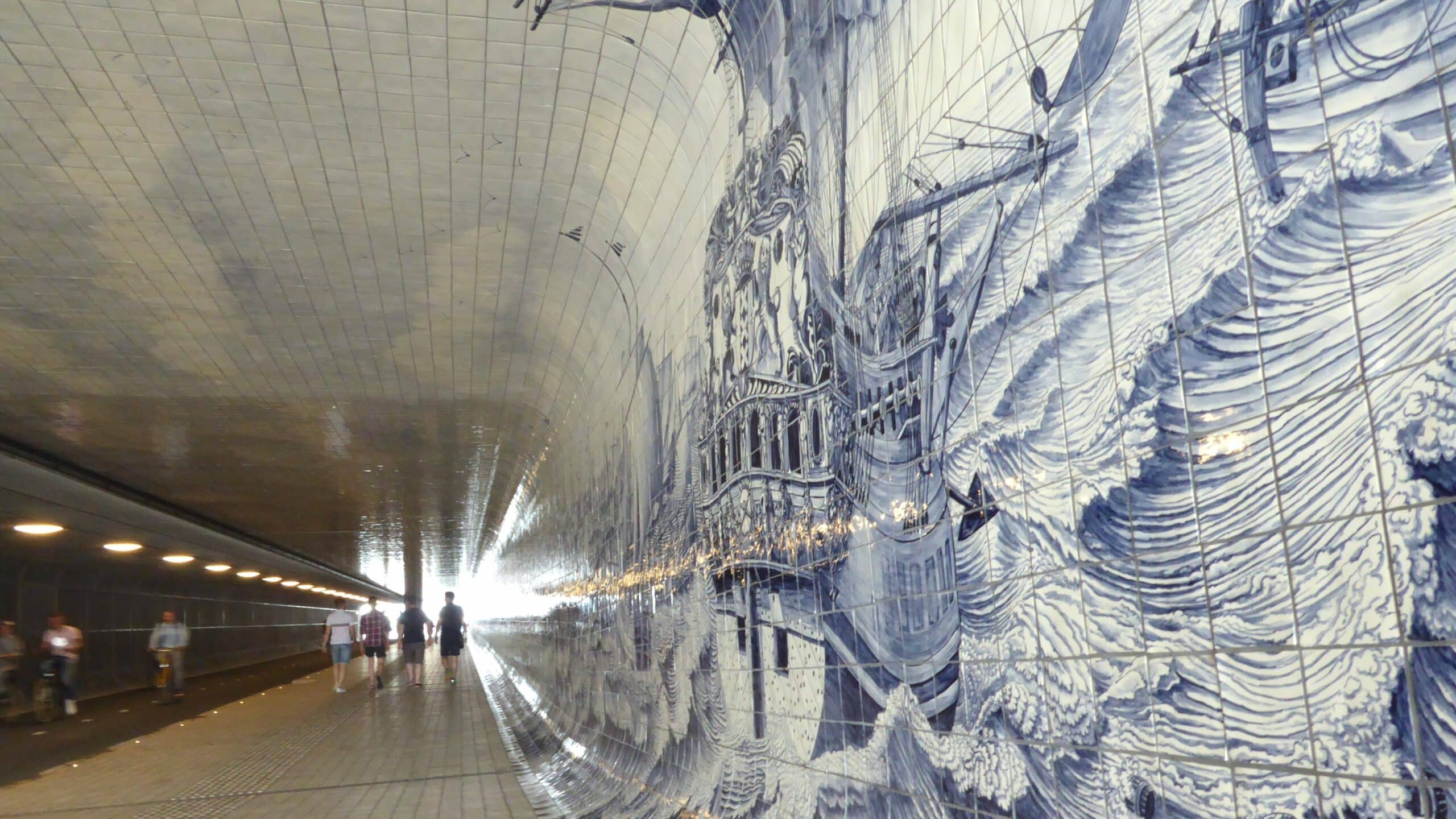
Cuyperspassage bicycle and pedestrian tunnel, 2016, Amsterdam
Today, we are still striving to enhance outdoor public spaces by introducing artwork within arm’s reach. My colourful brick and ceramic artwork built within the new Randall Close development aspires to bring elements of fun and create a welcoming space for all.
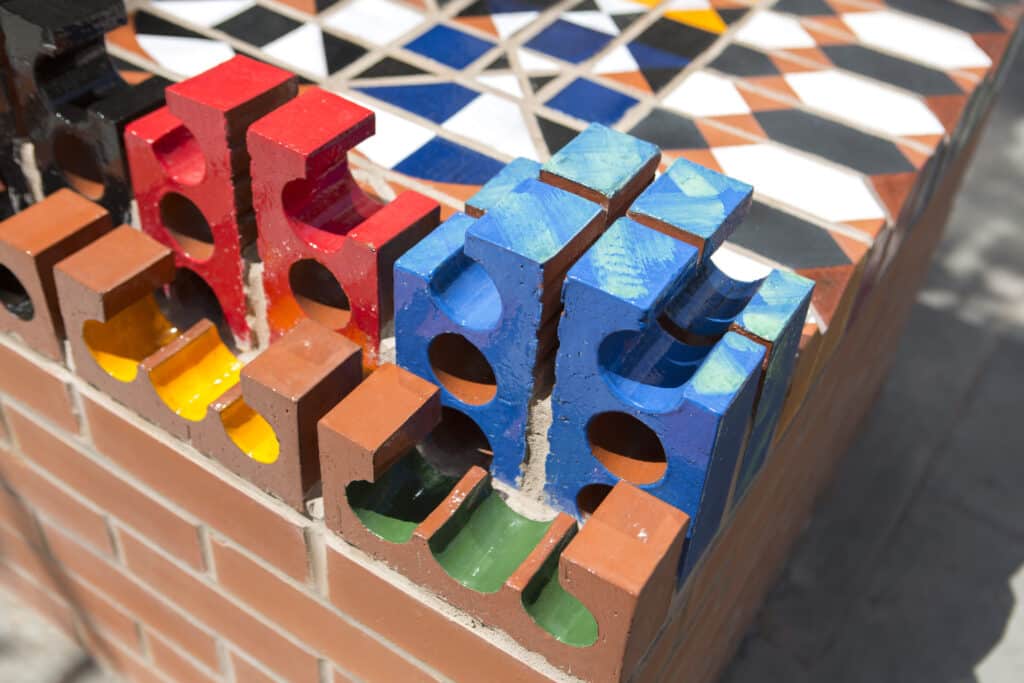

Photograph © Agnese Sanvito
Maria Gasparian, Ceramic City Bench, for London Festival of Architecture 2018.
With many thanks to the Battersea Society and Wandsworth Heritage Service for their help and to the students of St John Bosco College and Augusta Akerman for their work to create ‘Randall Tesserae’.
All photographs by the author unless otherwise stated.
References:
Ensing, R. (2013) ‘Jesse Rust & His Son, Vitreous Mosaic Manufacturers of Battersea,’ Andamento, British association for modern mosaic, 2013 Issn 1752-5578, volume7, pp. 4-11.
Ensing, R. (2017) ‘Jesse Rust and His Son, Vitreous Mosaic Manufacturers of Battersea,’ Glazed Expressions, The Magazine of TACS, the Tiles and Architectural Ceramics Society, Issue No.79, pp. 3-8.
Gasparian, M. (2017) Winston Churchill Memorial Trust. Glazed Architectural Ceramics in Public Spaces: Lessons from the Netherlands, USA and Hungary. Available at: https://www.churchillfellowship.org/ideas-experts/ideas-library/glazed-architectural-ceramics-in-public-spaces (Accessed: 27 February 2023).
Jesnick, I. (2013) ‘Corrosive Sublimate and other diableries’, Andamento, British association for modern mosaic, Issn 1752-5578, volume 7, pp. 12-21.
Tremayne, T. (2013). Gilbert Bayes: Maker of Images. Available at: http://gilbertbayes.com/video.php (Accessed: 27 February 2023).
Van Diemen, P., Heijda, T., Koers, N., van der Leeden, C., Pater, R and Wansing. R (2018), A work of art in brick: significance and restoration of Het Schip, Amsterdam, an icon of social housing and architecture, 1919-1921. Amsterdam: Amsterdam School Museum Het Schip.
Maria Gasparian is an award-winning ceramic artist and architect based in London. She holds Masters in Ceramic Design and a PhD in architectural ceramics from the University of the Arts London.
Maria won Unilever Sustainability Award for innovation in 2016 and was awarded Winston Churchill Fellowship to research global applications of architectural ceramics.
Maria’s sculptural and colourful ceramic and brick artwork aims to create multisensory experiences and to contribute to sustainable, socially inclusive and engaging environment.
The Randall Close Public Art Commissions have been commissioned by Dallas-Pierce-Quintero on behalf of Wandsworth Borough Council, who also oversees the project Steering Group that includes representatives of Wandsworth Council and the Hill Group. The Artist Selection process was also supported by a representative of the Royal College of Art.
Websites:
Maria Gasparian: mariagasparian.co.uk
Augusta Akerman: augustaakerman.com
Dallas-Pierce-Quintero: d-p-q.uk

